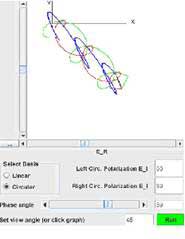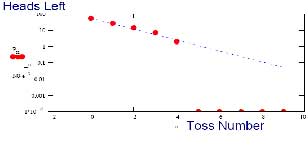Strategies for developing an educational component for an NSF proposal
Strategies for Developing an Educational component for an NSF proposal
John Cerne
The key questions that any proposal must answer are: What is the important problem that you are addressing? How will you contribute to resolving it? Why are you the one who should carry out this work? These same questions must be answered in the educational component of a proposal. I have addressed a number of challenges in teaching undergraduate and graduate students at the University at Buffalo (UB), and discuss three of them below.

Fig. 1. Interactive graphical Java applet shows how to create various states of polarization.
Problem 1: Conceptual understanding of waves. I have been teaching a large (~200 students) introductory undergraduate course (Physics 207) on waves, optics and modern physics every spring for the past decade and found that while most students could algebraically manipulate trigonometric functions, their understanding was superficial. For example, few students knew what would happen when a phase constant was placed in the argument of a sine function. Waves represent one of the most important concepts in physics, playing a crucial role in topics ranging from acoustical phenomena, electricity and magnetism, optics, Fourier analysis, and quantum mechanics. However, since waves have both a temporal and spatial dependence (often in more than one dimension) that may be difficult to visualize, many undergraduate and graduate students have a poor understanding of even basic wave concepts. Many of my undergraduate students claimed to have never seen functions with more than one argument. This made visualizing waves that depend on space and time extremely challenging. Part of the problem is that waves are typically explained using static and non-interactive pictures or perhaps only mathematical equations. In collaboration with a local high school teacher (Frank Nappo, Lockport NY) and two undergraduate students (Jaymee Minner and Michael Gerfin), we have attempted to explain many basic wave concepts using interactive graphical simulations, Conceptual Learning Approach to Waves (CLAW). There are many excellent web sites using similar graphical interactive tools, but they tend to focus on mechanics, electrostatics, and magnetism. My initial work was focused on polarized light, and I wrote several Java applets to allow students to manipulate the polarization of light using either a linear or circular basis (Fig. 1). Since my research involves probing the polarization of light, these applets have been very useful in explaining my work. With the help of Frank Nappo and Michael Gerfin, CLAW has expanded to cover a much wider range of wave phenomena, ranging from basic phase concepts to Fourier analysis (Fig. 2). These simulations have become an important part of my lectures for calculus-based physics courses as well as the magneto-polarimetry teaching lab that I have set up.

Fig. 2 Interactive simulation that allows users to visualize how and why Fourier analysis works.
Problem 2: Designing appropriate and stimulating research projects for undergraduate student. Every semester, several motivated undergraduate students ask me to supervise them in an independent research project. These projects last one semester and it can be very challenging to design a project that is interesting and worthwhile for students who may have very limited experimental physics backgrounds. Many times I have had to turn down motivated students because I did not have suitable projects available. I have created a magneto-polarimetry teaching lab for our Advanced Lab course, and also am using this lab regularly for independent research projects. The students use this system to characterize the latest magnetic semiconductor samples grown by Hong Luo’s molecular beam epitaxy group at UB, so that they become part of and contribute to the latest research that is being carried out at UB.
Problem 3: Traditional (monologue) lectures to passive students in large introductory courses. I have found that monologue lectures make poor use of the limited time that instructors have with their students and basically repeat material that is already covered in the textbooks. Many students leave physics courses intimidated and unenlightened. I was shocked to learn that one study (Redish et al., AJP 66, 212-224, 1998) found that university students’ understanding of what physics is about decreased after they finished their first semester of traditional introductory physics. This surprising result may not be so incredible when one realizes that most introductory courses teach physics as an encyclopedic discipline where one simply needs to memorize formulas that are written in large books. In my experience, traditional monologue lectures almost completely eliminate interactions between the instructor and the students (or among students), and probably could be replaced with videotaped lectures with little loss in effectiveness. Although, motivated students may actually ask questions and actively try to understand the content of monologue lectures, I have found that most of my students only learn and make critical conceptual connections in lecture when they are forced to think and respond actively. I also involve them in lecture demonstrations as much as possible, including one demonstration that I developed where all the students (~100) participate to explore radioactive decay. Each student is given a penny and all the pennies begin with the head side up, representing undecayed unstable atoms. Then the students toss their pennies and the number of remaining heads is recorded and projected on a semilog plot on the lecture screen. The toss is repeated for the coins that are still heads, and the new number of remaining heads (undecayed atoms) is plotted. The data are then fitted to an exponential function that is used to determine the decay time of the tossed pennies. Figure 3 shows an actual experiment/demo that involved 83 Physics 207 students in the spring of 2003. The atmosphere is quite gripping as the number of “contestants” is reduced from a hundred to a handful in several tosses.

Fig. 3. Coin toss experiment to demonstrate the concept of half-life in radioactive decay in lecture.
Although I have always tried to get students involved by asking them questions (and waiting the unendurably long period of silence for them to break down and actually answer the questions) and taking polls by asking for a show of hands, since 2007 I have been using clickers in my Physics 207 course, the first time at UB that clickers have been used in a calculus-based physics course. I have based my lectures in that course on Eric Mazur’s Peer Instruction and found the lectures to be much more interesting and varied. Polling the students has greatly helped me check the students’ understanding and has allowed me to adjust my lectures to address real, rather than perceived, problems in their understanding. Thanks to the clickers, I can give up to 5% extra credit for attendance/participation. Whereas I was lucky to get 50% attendance before the clickers, the average attendance now is around 70%. The extra points are certainly part of the increase in attendance, but I also think that students are finding the lectures more stimulating and useful, realizing that actively figuring out the material in lecture will save them time later. I have found clickers to be extremely useful not only for courses, but have also used them in two conference presentations last year, including the APS March meeting.
In addition to identifying and addressing educational challenges, I have found a number of strategies that can help in writing effective teaching components for proposals:
- Base the teaching components on your actual experiences and interests: There are many exciting new teaching techniques being developed and it is tempting to simply use educational buzzwords to make a proposal seem more credible. As a reviewer, I am much more impressed by proposals where the author shows genuine interests and real actions in teaching.
- Get in touch with people involved in physics education research: I have been fortunate to have been helped by and worked with many excellent people involved in physics education research. Thanks to Dan MacIsaac (Buffalo State College), I have established contacts with local high school teachers (for example, Frank Nappo, my collaborator on CLAW), while David Henry (Buffalo State College) and Chandralekha Singh (University of Pittsburgh) have given me a greater appreciation of the challenges and subtleties in assessing how (and how much) students learn.
- Participate in conferences and workshops that deal with education: In my first semester at UB, I was sent to the AAPT/APS New Faculty Workshop. This workshop opened my eyes to new teaching techniques and introduced me to people like Eric Mazur (Harvard), Evelyn Patterson (US Air Force Academy), Ken and Patricia Heller (University of Minnesota, Minneapolis), and Lillian McDermott (University of Washington, Seattle). I have also greatly benefited from attending two Cottrell Scholar Conferences, which focus on the challenges of improving education at research universities.
- Apply for grants that emphasize teaching: My best teaching proposals were developed for grants which value teaching. For example, the Research Corporation typically weeds out 50% of its grant applications based solely on the educational component. This greatly helps applicants with strong interests in teaching, encouraging them to spend more time and energy on their teaching proposals. My proposal for the Research Corporation’s Cottrell Scholar Award provided excellent preparation for my NSF CAREER proposal.
- Take advantage of your institution’s educational resources: Some teaching proposals that are well suited for one institution may not work as well at another. For example, I am very impressed by the studio learning approaches such as the SCALE-UP Project and Tutorials in Introductory Physics, but currently we do not have lecture space that could accommodate such an approach for our large introductory courses. On the other hand, all the large lecture halls at UB have excellent LCD projection stations with internet access, so online simulations such as CLAW are readily implemented.
- High school teachers are a great resource for educational and outreach ideas: Almost all the simulations in CLAW were written in Flash by high school teacher Frank Nappo. Furthermore, Frank is great at bringing high school students to our outreach events. For example, when we had an open house and public lecture a few months ago, Frank brought 70 students to the Department.
- Work with your University’s programs for minorities: I have found UB’s Cora Maloney College to be extremely useful in finding highly qualified and motivated students (e.g., Jaymee Minner who worked on CLAW) from under-represented groups to work on my educational projects. For example, Daniel Crowe, an Undergraduate Louis Stokes Alliance for Minority Participation summer intern, made a kicker circuit to drive the Foucault pendulum at the Buffalo Museum of Science. Having real contacts and experience with people and programs that support minorities strongly bolsters proposals that target minorities.
- Design education projects that will help, not hinder, your research: Not all proposed educational components interfere with research. I have found that my magneto-polarimetry teaching lab has helped my research and allowed me to start new research projects. The lab has provided a method to recruit and train students; has given me new experimental tools to start new research collaborations, and has provided a test bed for new experimental techniques that could not be attempted in my research lab due to lack of space and/or equipment availability. As an example, we are currently developing a polarization-sensitive confocal microscope using the magneto-polarimetry lab.
Writing proposals is one of the most challenging and stressful parts of academic life. For many faculty, the teaching component of a proposal only adds to the burden, or is relegated to boilerplate material that is only included to satisfy minimum administrative requirements. Instead, investigators can use this component of the proposal as an opportunity to explore creative ways to enrich the experiences of both the students and the instructor.
John Cerne is in the Department of Physics, University at Buffalo, The State University of New York.
Disclaimer - The articles and opinion pieces found in this issue of the APS Forum on Education Newsletter are not peer refereed and represent solely the views of the authors and not necessarily the views of APS.
